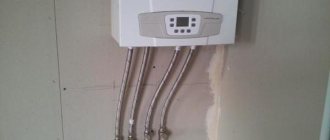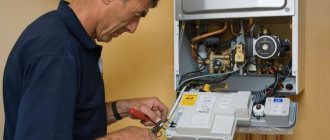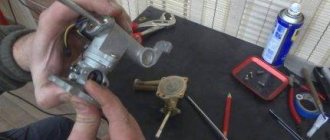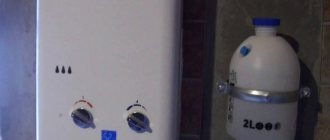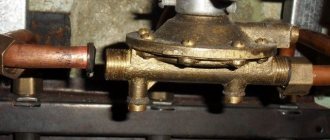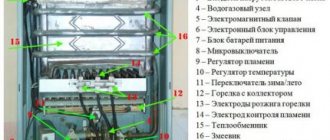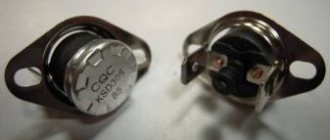The problem of lack of hot water is relevant not only in remote villages and towns, suburban private sector houses, but also in apartments of multi-apartment buildings. This is why water heaters remain in demand and are in demand.
However, like all technical equipment, in geysers, after a certain period of use, malfunctions appear that interfere with normal functioning. One of the most common problems is that the flame in a Bosch gas water heater does not ignite. In our article we will look at the reasons that cause this problem in various types of geysers and how to eliminate them.
Causes
It is worth considering that breakdowns can be of a very different nature. For example:
- the flame does not ignite (clicks, there is a spark, but it does not work or there is no reaction to switching on at all);
- goes out immediately or after a short time (both with automatic and manual ignition);
- the fire goes out when you try to turn on the water, increase the pressure or weaken it;
- the flame ignites, the water comes out lukewarm, and then the column goes out;
- the speaker pops, crackles, mini-explosions appear when turned on;
- piezo ignition does not work;
- the piece works constantly, but when ignited the flame goes out;
- the dispenser does not light up and there is a smell of gas;
- When the tap is opened, the GSV rod does not move.
Column malfunctions can be divided into breakdowns caused by external factors and those of a purely internal nature. The former are not related to parts inside the unit itself and depend on additional parts or external influences (for example, adding temperature).
External factors
External breakdowns are as follows.
- The most common situation is the lack of draft in the chimney of the column. If it is not cleaned, it will become clogged with dust and dirt, and combustion products will not find an outlet and will extinguish the burner. Then, when the security system is activated, the gas supply will be cut off.
- A foreign object could accidentally end up in the chimney.
- The unit could simply have run out of battery or batteries. This type of malfunction only exists if there is an ignition, which operates automatically using batteries.
- If the device does not work after the first installation or due to repair work on the plumbing system, then there is a high probability that the hot water supply line was simply connected in the wrong place.
- Reduced water pressure. It is necessary to evaluate the water pressure (it will be weakened, the water will flow in a thin stream). The ignition will stop working with low pressure, so the reason is no longer in the column, but in the water pipes. Although, it is likely that the filter itself, installed in front of the column, is clogged with something.
- A faulty faucet that adds too much cold water, causing the water in the tap itself to heat up too much and extinguish it.
- Electronics. Modern speakers contain a large number of control modules and sensors that control the operation of the entire unit. Their failures can lead to the gas stopping igniting.
Internal breakdowns
Internal factors are like this.
- Incorrectly configured water heater. Due to the change of seasons, the water temperature also changes, so the column needs to be adjusted, which is often forgotten to do.
- The membrane on the water unit has failed. If the membrane is many years old, it could have lost its elasticity, cracked, deformed, or become covered with lime deposits.
- Filters or heat exchanger clogged with soot and scale.
- The pilot or main burner is clogged with dirt.
- Problems with the gas outlet sensor.
- Pops or small explosions when trying to turn on the equipment can occur due to insufficient draft in the ventilation or blockages of various parts of the water heater.
Features of ignition of Bosch geysers
A flow-through gas water heater, commonly known as a “gas water heater,” is a technical device in which water is heated using the energy released during the combustion of household gas.
Different models of brand water heaters, differing in functionality and design, also have different types of ignition. Therefore, the reasons causing problems with flame ignition may differ. But in order to diagnose them, it is first advisable to familiarize yourself in general terms with the structure of the column.
The basic diagram of a gas water heater, used for all models produced by Bosch. The main difference between the models is the type of ignition and the location of the modulation control knob
Bosch geysers, despite many modifications differing in the type of ignition and performance, correspond to the general assembly diagram and consist of the following elements:
- gas fittings - a curved metal tube through which gas flows and gas supply control elements;
- gas wick - a device for igniting a flame;
- burner - the place where the gas combustion process occurs;
- heat exchanger - a special tank through which a tube with running water passes; this is the place where water is heated;
- combustion gas temperature sensors are a necessary element for monitoring the proper operation of the column;
- piezo ignition button - necessary to start the speaker;
- column modulation control knob - used to increase gas supply power;
- removal of combustion products.
Columns of different series may differ in the type of ignition, set of sensors and other design elements. Next, we will get acquainted with the main ones, which are important in the case of self-diagnosis of a malfunction.
Therm 2000 O Series
Affordable version. Average performance: 10 liters of hot water heats up to the required temperature in 1 minute. The device of this series is equipped with automatic ignition , which runs on batteries.
The design also includes sensors for gas supply control, flame control, and traction control.
The Therm 2000 O model has mechanical control and heating temperature limitation. Using the modulation knobs on the front panel, you can manually adjust the required gas supply force
Therm 4000 O Series
Models in this series are available in 2 versions: with automatic ignition from batteries and piezo ignition . They vary in power and can heat from 10 to 15 liters of water per minute.
Geysers of this model have a number of advantages:
- uniform regulation of column modulation, which allows you to maintain the set water temperature;
- heats water even at low flow pressure (sufficient pressure is 0.1 atm).
To differentiate by ignition option, the designation of these gas water heaters uses the letters B - columns with automatic ignition, and P - columns with piezo ignition.
The gas supply power regulator in the Therm 4000 O series dispenser allows you to more accurately set the water temperature. They are also equipped with the highest quality heat exchangers made of copper. Their serviceability has been increased to 15 years
Therm 4000 S series
Speakers of this series are often installed in apartments with problematic chimney installations. Air enters and combustion products exit in a coaxial chimney located on the outside of the wall.
An electronic control panel is also installed on the front side . This makes it possible to monitor the performance of the column (in case of a malfunction, information about the malfunction is displayed on the panel), as well as set the minimum error in water temperature - 1 degree.
The productivity is in the range of 12-18 liters of water per minute. The main disadvantage is that if there is no electricity, the speaker will not work.
Columns of the Therm 4000 S series do not require the installation of a chimney. Thanks to the presence of a fan, forced draft is provided. Installation of a coaxial chimney requires the help of a specialist
Therm 6000 O Series
The built-in hydrogenerator used in this series of gas water heaters allows automatic ignition of the flame when the water tap is opened.
On the front side there is a liquid crystal display that displays the temperature of the leaving water. However, this parameter is set mechanically using a regulator. The productivity of water heaters in this series is 10, 13 and 15 liters of water per minute.
The Therm 6000 O series water heater is equipped with HYDRO POWER technology, thanks to which there is no need for batteries or a piezoelectric element for ignition. The maintained water temperature is displayed on the front panel
Therm 6000 S and 8000 S series
These models were made for public use (kitchens of restaurants and canteens, public baths, showers in industries, hospitals, factories). They are able to provide hot water to up to 5 points without loss of temperature. The display is used to make settings. The ignition of this type is electric .
To ensure the operating power of gas water heaters of the Therm 6000 S series, several fans are used simultaneously. The Therm 8000 S models use condensation technology to efficiently heat the water flow.
The wick doesn't want to light up
If the burner refuses to do its job, or does it poorly, there may also be several culprits:
- The piezo element cannot work. Problems with the igniter are typical for Zerten and Astra speakers. It must always be on, and it can be activated when a button is pressed or when the mixer is opened. If this does not happen, the reasons should be looked for in the jets, which may become clogged. In this case, you will have to disassemble the device, get rid of the casing and start cleaning these holes. This can be done with a thin wire.
- The dispenser takes too long to light. Here the fault lies with the batteries, which are responsible for the spark that ignites the burner. If the spark does not appear, try changing them.
- The problem may be in the hydrodynamic system - the generator has broken down, thanks to the rotation of which energy is generated to produce a spark. This kind of repair is not recommended to be done at home, so you will have to go to a service center.
The wick of a Junkers geyser goes out: a reason specific to the model
There are also problems that are typical for certain brands of geysers. Thus, for example, for devices like Bosch Junkers and Zerten, the initial examination will be completely different.
Having installed a gas water heater, you can think about a gas boiler. This purchase will allow you to heat your apartment more economically.
For a Bosch Junkers column, the most typical problem is the failure of the thermocouple and igniter. After only 3 years of operation, the thermocouple begins to malfunction due to which the column may spontaneously fade out or not turn on at all. This problem can be solved by sanding the thermocouple.
If this does not help, then perhaps during cleaning you moved the igniter tube, which is not tightly attached in Junkers brand speakers. Due to this, the correct gas supply does not occur.
The water doesn't heat up well
Solution:
- Select a unit with greater power.
- Turn on hot water in different rooms alternately.
A blockage may occur in the burner or heat exchanger due to excess soot. This will be signaled by the red-white color of the flame at normal water pressure.
The solution is to clean the column, preferably with the help of a specialist.
If at first the water flows at an acceptable temperature, but gradually it becomes colder, the flame of the column is blue, and the light is weak, then the problem is in the integrity of the membrane. Cold water wedges into the hot flow, and the outlet temperature drops.
The solution is to replace the membrane.
The solution is to switch the hoses.
The draft in the chimney is to blame
The main burner may go on strike if the chimney pipe is clogged. Leaves, debris and soot clogging the channel cause the draft to decrease. Sometimes to such an extent that the protective system in the column is activated, shutting off the gas.
To make sure the version is correct, you need to open a balcony, window or vent, and then attach a sheet of paper to the ventilation hole (matches are evil). If there is traction, the leaf will stick to the grate. Otherwise, there is only one option left - turn off the heating device and call a team of chimney sweeps.
If your column is from, Ariston or Bosch, then it is equipped with a sensor that controls traction. In its absence, gas stops supplying.
Possible reasons
In case of incorrectly connected pipes, the water heater protection system itself blocks the gas supply, which is why it does not turn on. The pipe connection diagram is very simple:
The gas supply pipe is connected on the left, the cold water supply pipe is connected in the center, and the hot water outlet pipe is on the right.
It is also necessary to ensure that all gas supply valves are in the open position. It may well be that after installing new equipment you simply forgot to turn on one of them. All taps with yellow handles must be open.
No or poor draft in the chimney.
Accumulated soot, construction debris or other foreign objects entering the chimney can prevent combustion products from being removed through the chimney, which poses a danger not only to the health, but also to the lives of residents.
hood
You can easily check the presence of draft in the chimney yourself. To do this, you just need to bring a burning match to the inlet. If its flame rushes towards the hole, then the chimney is working properly. Otherwise, you will have to look for the reason why there is no traction. As you can see, an ordinary match can help eliminate a dangerous malfunction and protect your household from carbon monoxide poisoning.
If there is no draft, make sure that there are no obstacles above the ventilation shaft exit, such as a satellite dish. In this case, the problem can be completely solved without seeking help from specialists.
If no external circumstances interfere with the proper operation of the chimney, then you are definitely dealing with contamination. What to do in this situation? Of course, you can try to clean it yourself, but there is a possibility of damaging the branches from neighboring apartments.
Increased relay sensitivity.
The most likely cause of the malfunction is the increased sensitivity of the thermal relay, the protection of which is activated against overheating, stops the gas supply and the column goes out.
Column gas color
For methane or propane to ignite, it must be mixed with oxygen in a certain proportion. Depending on this, the color of the flame will change. By its shade you can understand whether the device is working normally or intermittently.
- Blue The color of the fire indicates that the mixing of gas from the gas pipeline and oxygen is in the correct proportion, the gas pressure is sufficient, and the burner is functioning normally.
- Yellow - indicates that not only gas is burned in the fire, but also particles of soot and soot. Dust adheres to the surface of the igniter and burner. It does not interfere with the passage of gas, but creates an obstacle for air. On the burner, gas and air are mixed in the wrong proportions. Often a yellow flame is observed in a new column in the first 3-4 months of operation, this is due to the fact that factory grease remains on the ignition group. It forms an oil film to which dust sticks.
- If the gas is burning orange flame, this means that the contamination of the injectors has reached critical levels. The burner needs to be cleaned urgently. The orange flame is often accompanied by smoking, and the flames may bounce off. But if this phenomenon is observed for the first time, you first need to check the position of the damper. If it jumps off or closes, the air supply is disrupted.
- Red color indicates danger. When methane burns, some carbon monoxide is always released. As long as its concentration is low, there is nothing to worry about. But if the flames acquire a red tint, this is evidence that the fuel is not being burned completely and that too much carbon monoxide is being produced. The speaker should be turned off immediately and the room ventilated.
You can only clean the burners yourself. All other work must be performed by a specialist.
Causes of breakdowns and their elimination
Despite the simplicity of the design and ease of operation, the flow-through heater is not immune to breakdowns. If the Vector brand geyser does not turn on, do not panic. There may be several reasons for the problem and most of them can be eliminated yourself.
Problem #1 - lack of traction in the column
The lack of draft indicates that combustion products cannot be promptly removed from the room. This poses a danger to users, so the sensor turns off the gas water heater.
Sometimes the burner lights up but goes out immediately. This can happen when there is not enough air to burn the gas - the flame goes out due to lack of oxygen to support combustion.
In any case, you first need to check the draft by holding a burning match to a special hole on the speaker body. If the flame is directed inward, then the chimney is working normally, combustion products will be promptly removed, but the cause of the malfunction lies elsewhere. If the flame remains motionless, directed upward or towards the user, then it is worth carefully inspecting the chimney and cleaning it.
Along with combustion products, soot enters the air. It gradually settles on the walls of the chimney, narrowing its opening. As a result, traction disappears. The problem can be solved by thoroughly cleaning the chimney
Problem #2 - difficulties with water pressure
Another reason why a Vector brand household gas water heater does not light up may be low cold water pressure or its complete absence. Before you start looking for a solution to the problem, you need to make sure that cold water is supplied without interruption and evaluate its pressure. If there is insufficient water pressure in the system, the solution may be to install a pump or replace old, clogged pipes.
If there are no problems with the water supply, you should proceed to inspect the column. The solution to the problem can be adjusting the water supply to the column. To do this, you must fully open the corresponding tap.
Another reason for insufficient water pressure in the column is a clogged filter. To inspect it, it is necessary to turn off the water and gas supply to the valves, unscrew the nuts, and rinse the mesh. If you cannot clean it, the filter will have to be replaced.
It will take a few minutes to inspect the filter. However, in some cases, washing alone is not enough; a complete replacement of the part is required.
Problem #3 - insufficient gas pressure
Sometimes the gas pressure is not enough to ignite the flow column and allow it to operate normally. However, you cannot solve such a problem on your own. You need to contact your gas service.
Problem #4 - no ignition when turned on
The presence of an electric ignition system ensures comfortable operation of the gas water heater and eliminates the use of a wick that is constantly burning. However, it is this element that can cause the device to malfunction.
When the tap is opened, automatic ignition should be triggered. This action is accompanied by a characteristic crash. If the ignition does not work or the spark is too weak to ignite the gas, the column will not be able to connect. Replacing the batteries will help solve this problem.
For uninterrupted operation of the instantaneous water heater, batteries are required. When the batteries are discharged, the electric ignition does not work and the speaker does not turn on.
Problem #5 - clogged pipes
Water and gas pass through the Vector gas water heater during operation. Using filters allows you to clean them from unnecessary impurities. However, the presence of blockages may cause the device simply not to turn on.
However, the filter is not always able to bring water to an ideal state. Soluble salts enter the heater along with the liquid and settle on the walls of the heat exchanger. As a result, the patency of thin tubes is impaired.
Specialists remove scale using specialized reagents. A home technician can deal with it using a solution of citric acid or vinegar. To clean the heat exchanger, you need to remove it and place it in a warm solution with vinegar added. You can also use special purchased products - “chemicals” designed for cleaning heat exchangers.
It is better to entrust the removal of heat exchanger blockage to qualified craftsmen, since the tubes are fragile and, in the absence of specialized skills, can be easily damaged
We discussed cleaning and repairing the heat exchanger in detail in the next article.
Answers from users on repairing the Junkers geyser
Question: I have a Junkers WR-10 gas water heater installed and it takes a very long time to tinker with its ignition. Piezo ignition. At first you have to hold the button for a long time (about a minute). Then the piezo igniter somehow does not ignite it (rarely). Well, it doesn’t bother me anymore - we’re used to it. We light it with a match - after holding the button for a minute and a half (apparently so that the gas accumulates). Then, when the wick is still lit, hold the button for about a minute and only then move it to the right. Tell me what could be wrong. It's very difficult to light it.
Answer: The reason is simple - gas comes out of the tube. Therefore, until the tube is filled with gas, the wick does not burn (described in the manual). This column should operate in standby mode on wick. If you're worried about the wick constantly burning, buy an automatic one.
Question: The wick lights up, I keep it in this position for 5 minutes, switch it to working condition, it goes out. Gas water heater Junkers Bosch semi-automatic! Why is this so, what should I do?
Answer: I had the same problem. I removed the housing, disconnected the tube through which gas is supplied to the wick, and blew it out with a pump from the bicycle. put it back - everything works! as one speaker repairman explained to me, this needs to be done once a year, especially after the summer, when the windows are open and dust, etc. gets clogged up in this tube.
Question: We installed and started up a Junkers gas water heater and the problem is constant in winter. There is also not enough gas, and besides, the gas that is often supplied is not pure. But it’s European, they don’t understand what red gas is instead of blue.
Answer: on your column at the bottom there is a screw under a seal (blue plastic). You remove it and, with the burner on, turn it counterclockwise within reason (you will see it by the flame). You'll be back for the summer. If this doesn't help, the pressure may actually be low.
Question: I use a Junkers WR-275 gas water heater in my house. Over the course of 10 years, two columns of the specified company and brand failed. I didn’t clean the first one at all - it worked for 5 years and the heat exchanger leaked. The repair resolved the issue for 3 months and a new one was purchased. The installer said that the whole problem was that he did not do maintenance (cleaning). So I cleaned the new one. Result: I worked for 4 years. The reason for the failure is the same - the heat exchanger. Why is this happening?
Answer: You simply have a problem with water quality. Because of this, heat exchangers fly.
Question: after the column has been running for 2-3 minutes, it turns off completely, after which the wick can only be lit with matches. Does anyone know what to do with Junkers?
Answer: There was such a problem, they changed the water overheating sensor. Everything works well.
Question: The Junkers burner worked for 7 years. The igniter does not work. and if you light it with matches, the wick goes out when moved to the working position. what can you recommend?
Answer: I have the same problem. The technician said that the thermocouple had burned out.
Question: Column Bosch Junkers WR-13-2. Installed two years ago. From the very beginning there were problems. The first time I couldn’t light it for about half an hour. Something was stuck there and the column did not want to light up. Then something clicked and it seemed to start working. And so it worked for two years, igniting every other time. And now I’m starting to get really weird. The display shows a temperature of 40 degrees, and the water flows a little warm. You increase the temperature with your hands to normal to wash, and the display shows 62 degrees!
Answer: The thermometer there has no connection with the gas supply and burner power. It's just a thermometer. Well, this what’s-its-name generator. With our water and its pressure, this is often a useless device. And sometimes it works, but there is not enough power, especially during ignition, since at this time the maximum current is consumed. Treatment is switching to batteries.
Checked, the symptoms are exactly the same - ignition every other time, puffing, etc. since the spark is weak and cannot ignite the burner. At a minimum, for starters, connect the power from two new R20 alkaline batteries in parallel (without mixing up the polarity, red is positive, and the connection should be 1.5V, not 3). Regarding the thermometer - if it is lying too much - most likely the temperature sensor has gone sour, replace it.
Question: please tell me the electronic unit of Junkers gas water heaters, why might it fail? Explanations from the service technician due to power surges in the network. I don’t understand something, the speaker is not connected to the network. Who has encountered this?
Answer: We will try to help you. The house is equipped with a Junkers WR-10 B gas water heater. The water heater did not work for even a year and suffered its first failure - the burner stopped turning on (but the igniter did light up). The reason is a breakdown of field-effect transistor Q2 in the electronic control unit (without it, the circuit does not sense the burning igniter and does not want to open the burner valve).
I replaced the broken transistor with a KP303V (KP303B should also work). It turned out great, but a month later it was rejected again. I replaced the transistor again, but it barely lasted a couple of months. Having replaced the transistor (Q2) for the third time, I bypassed its gate circuit with a varistor of type 390KD07 (39V), i.e. added a new component to the circuit. This protection turned out to be sufficient - the speaker has found a new life and has been happy for 3 years!
Question: A Junkers WR-13-P gas water heater with piezo ignition is connected. We bought it in January 2008, that is, it is not even a year old. It worked without any complaints. We were very pleased. This afternoon the column simply turned off (the flame went out). Trying to light it again was unsuccessful; I can’t even light the igniter. I checked the hood and everything was fine (I thought the hood control sensor was cutting off gas), the gas pressure was also normal. The question is: What could be the matter? Has anyone encountered such a problem?
Answer: Try cleaning the igniter. Perhaps you need to check all contacts: on the thermocouple, overheat sensor.
Question: Gas. Column Junkers WR 13-P, installed about 4 years ago, used little, sometimes did not turn on for several months (due to departures), a year ago, began to go out periodically, then did not light up at all (when you release the button, the igniter goes out), they called a technician from the service center, he came and rubbed sandpaper over the thermocouple several times - everything worked. Three minutes, and not such a cheap call. Six months later, the same story again, the igniter goes out as soon as I release the button, I, like a master, periodically cleaned the thermocouple with fine sandpaper, at the very least it worked.
But now nothing helps, the igniter tube is clean, the heater is not clogged (the pressure is normal), the overheating and draft sensors seem to be normal, there is draft. Apparently the problem is in the thermocouple, I called to find out about the money and the work, the cost is half a new column. A little expensive. Does it make sense to change or buy a new one? Is it generally possible to somehow directly short-circuit, bypassing the thermocouple, or install a thermocouple from another, cheaper brand?
Answer: Maybe my experience will be useful. Symptoms: The igniter does not light, if you manage to miraculously ignite the igniter, then the gas water heater works for a short time until the hot water is turned off for the first time (the igniter goes out again). One of the reasons: The igniter flame does not reach the thermocouple or reaches it, but is unstable. The igniter in a Junkers gas water heater is usually secured with two clamps. Over time, for one reason or another, the igniter tube becomes displaced (when trying to clean it, igniting it with matches (and probably everyone has tried this), or in the “hearts” - they tapped the tube with something).
If you pay attention, you will see that the tube is not rigidly attached to the gas outlet from the column. Try adjusting the gap between the gas supply hole in the tube and the igniter tube itself, so that air enters the tube along with the gas and draft appears. You will immediately see that the flame from the igniter will lengthen and “lie” more horizontally and will reach the thermocouple. And the wick will light up more stable from the piezo spark.
Question: Can you tell me where the Junkers WR-275-1 geyser can have water pressure adjustment? The instructions only describe adjusting the gas pressure (screw under the sealed lid), but nothing is written about water. I suspect the healthy screw is at the very bottom of the block, but I would like to clarify.
Answer: This means there is no water pressure adjustment. On such columns, only a flow regulator is installed - a large knob on the front panel. But for real pressure regulation you need a reducer - they are not installed in columns.
Question: Column Junkers WR 275-1, everything worked fine before. It hasn’t been used for about a year, and now the gas doesn’t turn on when you turn on the water (the ignition is still on). Please advise what can be adjusted there?
Answer: The rod is soured or the membrane of the hydraulic flow sensor is torn. The gas regulator may be in the “Ignition” position. If the former, then try to disassemble and check the rod and membrane. The hydraulic unit is located at the water inlet to the column. This is a large flat round frog to which two pipes are screwed - from the cold water inlet and a tube going to the heat exchanger. It is necessary to unscrew both water tubes and remove the assembly.
As a rule, it is fixed with 2-3 screws. After removing the assembly, you will see a thin rod that presses on the gas control valve. Once you disassemble the unit, you will immediately understand its design. Just remember the position in which the membrane is placed. Inspect the membrane for tears. If the membrane is damaged, then only replace the membrane, but this is very rare. It is best to lubricate the rod with a greasy, water-resistant lubricant. You can disassemble the hydraulic unit as much as you like, but don’t get into the gas part. The malfunction is standard, it can be treated quickly and without problems.
Question: There is the following problem with the Junkers WR 275 gas water heater. To start the water heater, you need to turn on the hot water at full blast, reducing the pressure - the water heater goes out. I monitored the reaction of the column to manipulation of the hot water tap - it reacts, but only in the upper position, that is, it is not possible to set a convenient low pressure; when washing dishes, for example, water scatters throughout the kitchen. It is not possible to measure the water pressure in the system; it is impossible to hold the water in the tap by turning it off with your finger (due to the pressure). Is it possible to somehow make the column react and turn on with less water pressure?
Answer: All speakers do not like to work on a small flow. If it worked fine before, but now it has become bad, then disassemble the frog and change the elongated membrane. At the same time, it is very useful to lubricate the rod with a fatty, water-resistant lubricant. This unit is responsible for turning the gas on/off.
Question: How can I turn down the gas supply when the water is very hot? The lamb is turned all the way down. Does not help.
Answer: There are two user adjustments on Junkers WR 275 geysers. The first is a lamb, which can be used to reduce the temperature at the outlet of the device by allowing part of the flow to bypass the Venturi. the second is the burner power control knob. It has three positions - burner off, ignition - minimum power, maximum power. If the water temperature is still hot when the flow regulator is fully open, move the burner power regulator to the minimum position; the temperature should drop. If not, then look for the gas supply adjusting screw. It's under an aluminum cap. It’s always like this for summer, but you’ll have to put it back for winter.
Question: Yesterday the gas heater went out when the hot water was turned on, I tried to light it, but it didn’t work. I put the slider in the center, click on it, click the piezo. The wick burns while I press the slider, as soon as I let go the wick goes out. I tried a hundred options, but the wick goes out. Tell me if anyone knows what the reason is?
Answer: the thermocouple is washed by the igniter flame; it must be completely in the flame. there is a blockage and the flame barely touches it, then such a defect is possible or the thermocouple itself is covered
Question: We use a Junkers gas water heater. If gas does not flow due to incorrect adjustment, how can I check/adjust it correctly?
Answer: There are two types of speakers: 1. With a constantly burning igniter. Everything is extremely simple there. I pressed the start button, the gas went only to the igniter, ignited it with a piezo ignition or a match, the igniter caught fire. Wait 10-15 seconds during which the gas control thermocouple warms up and you can release the start button. The igniter burns due to the flow of gas through a valve, the coil of which is powered by electricity from a thermocouple.
Keep in mind that there is a poor draft protective thermostat in series with this coil, located at the top of the column near the chimney connection point. The operating philosophy of all speakers is the same, regardless of manufacturer. In principle, speakers of this type can be repaired by any technically competent person. The main thing is not to climb into the gas part. It is, as a rule, eternal. All faults in these columns are in the plumbing or weak chimney draft.
2. Junkers geysers with automatic start. Everything is more complicated there. The gas ignition circuit is started by a signal from a microswitch, which is triggered by a water flow sensor. After this, the gas supply valve to the igniter opens, which supplies gas for about 15-20 seconds, and then turns off. Simultaneously with this valve, the ignition spark generator begins to operate. The control circuit begins to control the ignition of the igniter based on the ionization current (for this purpose, there is another electrode next to the ignition electrode).
There is no thermocouple there. If the ionization current does not appear within 15-20 seconds, then the supply of gas to the igniter and the generation of a spark will stop. Then everything will repeat only after closing/opening the water. When an ionization current appears (ignition of the pilot), the control circuit gives a signal to open the main gas valve, which opens gas to the burner.
There is a modulation unit in series with the burner, which regulates the gas supply depending on the water flow rate and the readings of the hot water temperature sensor. Often a power regulator (winter/summer mode) is installed in the gas path, which limits the power of the burner. Naturally, the gas supply stops when the low draft sensor is triggered or when the water flow stops.
__________________________________________________________________________
__________________________________________________________________________
_______________________________________________________________________________
The gas water heater in many apartments has long replaced the central heating network. The fact is that such a device is much more convenient. After all, thanks to it, you can regulate the temperature of warm water yourself, and you also have to pay much less for utilities. However, geysers also have their drawbacks, first of all, these are periodic malfunctions in the form of their unexpected extinguishing. Why such a problem can arise and how to deal with it - read on.
Electronics malfunction
The draft sensor in geysers is usually located on top. It is attached to the chimney.
Modern geysers have many electronic units and sensors on board - only the simplest models do not have them. Sensors monitor draft and the presence of flame (ionization control), monitor the water temperature and automatically regulate the degree of its heating. If one of the sensors fails, the gas water heater will malfunction. The most typical malfunction is a breakdown of the draft sensor in the exhaust gas manifold. As a result, the electronics will not give the go-ahead for ignition. Failures also occur in electronic modules installed in many geysers. Repairing them is complicated by the fact that this requires special knowledge in the field of electronics and circuit design. If you are sure that electronic components are faulty, but do not have the necessary knowledge, feel free to call a specialist.
How to prevent malfunctions
Each model has its own operating features, which need to be studied.
To prevent equipment breakdown, you must follow the rules for its operation . It is important to follow both the general recommendations for handling gas appliances and the manufacturer's instructions.
Studying the instructions
A detailed study of the instructions in most cases guarantees normal operation of the column. The document describes in detail the rules for handling a specific device, taking into account its type, design and purpose.
For example, dispensers with a constantly burning wick should be turned on long before using hot water. This is usually done in the morning so that the tank has time to warm up a large volume of water. Automatic units start immediately after opening the hot water tap.
Ignition of the column is carried out using different methods: piezo ignition, electric ignition, matches . And in each case the algorithm of actions is different.
Setting up a geyser
In old storage boilers, the water temperature is regulated only by changing the combustion intensity.
To do this, you need to disassemble the housing and tighten the nuts on the back of the gearbox. In flow-through devices, the temperature is changed by changing the speed of water passage.
If the device is controlled manually, you can adjust the parameter using levers. The left one is usually responsible for gas, the right one for water speed. It is used to determine the temperature of the liquid and the operating limit of the burner.
to set the desired heating on a column with an electronic display : just select a mode from the list.
The automatic device is configured by a specialist during installation.
How to care for your equipment
There are a number of general provisions that should be followed when operating speakers of any type and design. The rules are as follows :
- if there is no draft in the chimney channel or with reverse draft, it is prohibited to start the device;
- for normal operation of the boiler, good ventilation is required;
- You cannot turn on and light the device without studying the instructions;
- It is strictly forbidden to change the design of the column;
- You should independently monitor the cleanliness of the chimney, ventilation, mixing filters and other devices;
- In case of malfunctions, contact the service center or gas service.
Problem with clogs
Filters are often installed at the entrance to the gas water heater, which filter out small solid impurities contained in the water. Salts also settle here, becoming an obstacle to the normal passage of liquid. As a result, the water heater stops lighting up and providing the household with hot water. In this case, you need to turn off the water supply, unscrew the filter and clean it. If the condition of the filter is very severe, then it is easier to replace it.
To clean the heat exchanger, soak it in a solution of water and detergent, and pour citric acid into the tubes to the top and leave for half an hour.
Also, during many years of operation of the column, the tubes or heat exchanger may become clogged. In this case, you need to check the permeability of the water unit and make sure that the heat exchanger is permeable. Blockages are removed by washing with special reagents - to purchase them, you should contact your nearest hardware store. After flushing, the functionality of your geyser will be restored.
In order to prevent sediment from clogging the inside of the column, install a decent filter at the entrance to the column, which will remove small impurities and soften hard water.
Incorrect water heating
The cause of this problem may be the incorrect choice of installation power. To do this, when purchasing, you need to make sure that the gas water heater from Bosch or another company has the necessary characteristics for your home. In addition, the device may be clogged. This is confirmed by the presence of soot and the uncharacteristic color of the flame. If the heating is insufficient, you can try adjusting the energy supply. This is done using a special tap.
There is also the opposite situation - the water is too hot. Here, the Bosch gas water heater does not require repair, since this is not considered a malfunction. This is because in summer the water temperature in the water supply is warmer and the pressure drops. Many geysers are not designed for this mode. The characteristics of geysers include the optimal water pressure, which ensures normal operation of the unit. The solution to this problem is the following: it is necessary to reduce the energy supply.
Basic ways to turn on gas water heaters
Today, various options for switching on gas water heating equipment are practiced, the choice of which directly depends on the design features of the device.
In any case, before turning on the gas water heater, a number of measures must be taken that will allow the trouble-free operation of such equipment. It is imperative to open the valves for supplying fuel and water to the water heating system.
How to light a gas water heater: manual ignition
This method of ignition is practiced when using outdated models of geysers and involves igniting the wick with matches.
The technology for manual ignition is simple, and consists of opening the water supply connected to the water heating equipment and the main valve for the gas supply, after which the wick is ignited.
A decrease in water pressure is not accompanied by switching off the device, so switching off is also done manually.
Piezo ignition
The presence of piezo ignition in the gas column greatly facilitates the operation and maintenance of such equipment.
The wick in such designs is ignited by pressing a special button. The ignition of the main gas burner requires turning on the regulator for the gas supply.
Pressing the button causes a spark to form and ignite the wick.
In models with piezo ignition, placing the regulator in the initial position and turning off the water supply does not extinguish the ignition wick, and the main disadvantage of such equipment is increased fuel consumption.
Automatic switching on
Today, gas water heating equipment is presented in a wide range, and improved, convenient models with an automatic system for igniting the wick and igniting the main burner have become especially popular among consumers.
As a rule, such columns have an installed turbine driven by water pressure.
Starting the turbine causes automatic operation, but in this case quite high demands are placed on the water pressure in the system.
Video description
Where to start repairing geysers - the simplest causes of breakdowns are shown in this video:
Water pressure too low
The requirements for the operation of gas equipment indicate under what conditions the device can be operated and what is needed for its normal operation. If the pressure is weak, the water heater will not turn on and this does not mean that it is out of order. The problem is related to non-compliance with technical conditions. To normalize operation, you can use a storage tank and a booster pump.
In automatic heat generators, the water unit does not work at low pressure. This is due to the peculiarities of the structure and operation of the element. There is a membrane in the inner part. It divides into two cavities, inside one of them there is a rod that is responsible for regulating the gas supply. In order for the rod to move, the membrane must press on it. If the water pressure in the pipes is low, the rod remains motionless and there is no spark, therefore gas is not supplied to the burner.
Possible other malfunctions
A heavy burden of blame may also lie on other smart devices in the gas water heater.
Failure of the electronics that control perfect operation will lead to the opposite result. Sometimes electrical wiring is damaged, and sometimes problems occur in the operation of various sensors. Such “disasters” require the intervention of a specialist who can, using diagnostic equipment, accurately determine the cause, and then repair the unit.
Incorrect setting of the igniter can lead to the fact that if there is insufficient gas pressure, the spark does not reach the comb, and the fuel misses the target. Therefore, the electrode must be installed exactly in the center of the burner, then there will be no problems with ignition.
Improper use of the speaker can also lead to troubles that can even lead to failure of the device. We are talking about turning on cold water while the device is operating. At this moment the column goes out. This happens because the pressure of hot water becomes too low. Therefore, it is the regulation of hot water at a certain temperature that is the main condition for the smooth operation of the device.
Prevention of geyser malfunctions
In addition to troubleshooting, you need to know how to properly disassemble a gas water heater. These skills are essential for doing DIY maintenance. Why do you need to know not only the constituent elements, but also the sequence of actions when disassembling the column.
You can perform all maintenance items on a geyser without the help of a technician. The main thing is to follow the sequence of actions and do everything quite carefully
Carrying out periodic preventive maintenance throughout the entire operational life of the gas water heater will contribute to correct operation.
Annual cleaning is recommended in the technical documentation by the manufacturer. After all, it is the lack of cleaning during prolonged use that can lead to all of the above problems.
Problems with ignition
Why doesn't the gas heater light up? It happens that there is very little gas pressure in the pipes. Look how the gas stove burners burn. Such fuel supply should be reported to the gas service.
Neva and Vector water heaters have electric ignition. If draft, pressure, gas supply are normal, but the column does not ignite, the reason may be the generation of a spark. When you open the tap, a characteristic cracking sound should be heard. We are trying to replace the batteries.
When using hydrodynamic ignition, you should check the operation of the generator. Such repairs will require certain knowledge and skills.
Gas water heater Astra automatic with electric ignition. The reasons that prevent the device from igniting are still the same. It may also not light up if the gas and water shut-off valves are closed. You just need to open them.
Other reasons
The gas water heater lights up and goes out due to a failure of the mechanism that allows access to the gas. This is a solenoid valve and a servomotor. You'll have to call a specialist.
Over time, the tubes in the column may become clogged. You need to make sure they are passable. In case of blockages, special cleaning agents are used.
Burners in gas water heaters often become clogged. Why is this happening? The reason is the accumulation of soot. It is necessary to disassemble the column, remove the burner and clean it with any tools. At the same time, clean the heat exchanger.
The membrane may rupture. It's difficult to buy.
It is necessary to check all the details. Many speakers have electronic components and sensors. For example, in a Neva gas water heater, the draft sensor often breaks down, as a result the device will not light up.
Electronic components will most likely have to be repaired by a technician.
So, you know what measures to take if the gas water heater does not light. We fix many breakdowns ourselves, and in more serious cases we turn to specialists. When repairing a gas water heater, all safety measures must be observed. Always turn off the gas. It is better to clean the gas water heater outdoors.
Geyser Junkers: wick does not light (video)
If the speaker fades out, then do not rush to call a specialist right away! Perhaps by understanding the problem and identifying its cause, you will be able to fix the problem yourself. But if it doesn’t go out when you turn off the water, it’s better to contact the gas service.
Attention, TODAY only!
15 Feb 2013, 08:08
The service center installed a closed gas water heater a month ago. Not even 30 days had passed when for some reason it began to turn off on its own sometimes. Sometimes you stand, take a shower, and then suddenly the water is cold.
What a surprise! In short, it shouldn’t be like this, you need to think about what the problem is and how to solve the problem.
15 Feb 2013, 08:15
How long does it take to shut down? if strictly after 20 minutes - this is how it should be; in Chinese models there is a special timer that turns off the device from operation after 20 minutes of operation. This was probably done for security reasons, I don't know.
The thing is quite inconvenient, sometimes you have to get out of the shower naked and start it again manually. But nothing can be done.
Overheat
Most often, overheating occurs for the following reasons:
- The user dilutes hot water with cold. Due to the addition of cold water, the consumption of hot water is reduced, therefore, the heat extraction is reduced and the water in the heat exchanger overheats. Remember: you can regulate the temperature of hot water only by changing its pressure or using the regulator on the column.
- The heat exchanger is clogged with scale somewhere. This also leads to a decrease in water consumption with subsequent overheating. You can guess what happened by the clearly weakened pressure of hot water, despite the fact that cold water flows properly. To prevent such troubles, the heat exchanger must be periodically washed with special anti-scale compounds.
If the mesh filter (dirt filter) installed on the water supply in front of the column is clogged, the flow rate in this case will drop with all the ensuing consequences.
Problem with traction
If the chimney is clogged with soot or debris, the exit of combustion products is complicated. The following threats arise:
- Carbon monoxide returns along with the air into the apparatus and extinguishes the burner. The column's defense is triggered, stopping its operation.
- The situation is the same as in point 1, only the return of the dangerous mixture occurs into the room. In this case, the health of the residents may be seriously affected.
The ventilation tunnel needs to be checked. A lit match is brought to his entrance.
If the fire is deflected inward, then there are no problems with draft. In another case, prompt measures are required:
- Checking the presence of an antenna above the ventilation shaft exit. Ask your neighbors to move it.
- Call specialists to cleanse this channel.
